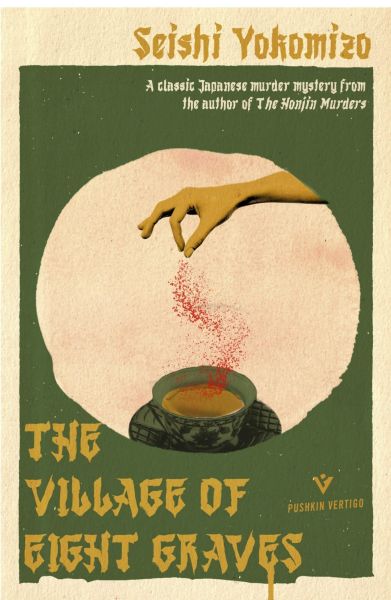Kill Kill Kill
The Village of Eight Graves (Kosuke Kindaichi, volume 3)
By Seishi Yokomizo (Translated by Bryan Karetnyk)

10 Nov, 2021
1971’s The Village of Eight Graves is the third novel in Seishi Yokomizo’s Kosuke Kindaichi mystery series. The 2021 English translation is by Bryan Karetnyk.
Tatsuya survived unspecified unpleasantness during the conflict of the early to mid-20th century and returned to Japan to discover that he no longer had a family or home. His mother is long since dead, his step-father has died during the war, and his step-family has scattered to parts unknown. Having no other choice, he has built an unremarkable solitary life for himself in the Japan of the 1940s.
Thanks to his late mother’s unwillingness to speak of her past, Tatsuya has no idea that he was born into a family, and a rural village, scarred by terrible events. Ignorance is no defense. History seeks him out.
The aging matriarchs of the Tajima family summon Tatsuya to their home village. They believe that he is their long-lost nephew. As such, he is the Tajimi family’s only healthy, adult male heir. Such good fortune! Save for the fact that the community to which he is summoned is the ominously named Eight Graves.
In 1566 eight fleeing samurai made the terrible error of trusting villagers in an isolated mountain community. Coveting the 3,000 taels of gold the samurai were carrying, the villagers lulled the warriors in a false sense of security, then murdered them all. The peasants did not find the gold. They did appear to have brought a terrible curse on the village, one that abated only when the dead samurai were given proper burials. It is from this massacre the village of Eight Graves takes both its name and the ill-fortune which periodically revisits the town.
In the 1920s, the curse reappeared in the form of Yozo, the head of the Tajima family. He was a cruel brute who kidnapped and imprisoned the beautiful Tsuruko. He was rich and powerful; she was defenseless. The villagers bullied her into remaining as Yozo’s mistress, for all would suffer his wrath if she escaped. She was finally saved when Yozo, maddened by jealousy, slaughtered thirty-two people and fled, never to be seen again. Before she escaped, she had born Yozo a child: that child was Tatsuya.
Tatsuya is intrigued by the possibility of having a family again, despite their horrific history. He returns to Eight Graves to take up his new position. It does not go well.
The murders begin even before Tatsuya sets out for Eight Graves. One by one, people connected to Tatsuya die in poisoned agony. Is this the return of the village curse? Is a villager to blame? Or could it be that Tatsuya himself has fallen prey to the same hereditary madness that possessed his father? That he commits murders in fugue states without remembering them?
Unconventional detective Kosuke Kindaichi happens to be passing through. Can the rumpled detective unravel the mystery? Or must the curse again devastate the village of Eight Graves?
I’ve read three of Kindaichi novels thus far and no two of them share a translator. I wonder why that is.
Japan is not Great Britain, but if we are to believe mystery writers, both countries share a tendency for small communities to become pestilent nests of entrenched oligarchs, inherited madness, long-standing grudges, and horrific murders of such frequency that veteran soldiers would shudder at the carnage1. To visit a rustic community in either nation is to put one’s own life at risk. If so, it’s amazing that any Japanese or British rural communities have survived to this day.
What would have been a sufficiently fraught mystery setting is further complicated by the fact the book is set in the aftermath of the Second Sino-Japanese War and World War Two, historical facts that the novel brings up using impressively evasive terms. Many cities are rebuilding from smoldering ruins and society is upended, which puts additional strain on communities already inclined to resolve their differences with sword and poison.
Readers who like novels in which killers are Byronic master manipulators should look elsewhere. The author’s murderers incline towards the insane and the hopelessly petty. Murder reflects a lack of self-control, not the expression of grand passions. Homicidal people are dangerous but also pitiable.
For that matter, the focus is not on the brilliant detective but rather one of the hapless figures entangled in the mystery. Poor Kindaichi’s role does not include character growth; he’s just a convenient mechanism for justice. It’s Tatsuya who changes over the course of the novel, in circumstances if not character.
This is not deep challenging literature2, but readers looking for a quick, engaging mystery that offers glimpses of pre-and post-war Japan will find this diverting.
The Village of Eight Graves is available here (Amazon US), here (Amazon Canada), here (Amazon UK), here (Barnes & Noble), here (Book Depository), and here (Chapters-Indigo).
1: Not a figure of speech. Poor Tatsuya, who survived certain regrettable events during the Shōwa era, spends much of the book legitimately terrified for his life and sanity, as well as the lives and sanity of those around him.
2: Editor’s note: blurb for this book suggests that it hits the same sweet spot that Agatha Christie mysteries do. Yeah, it hits the same spot, but it’s not a sweet spot for me. One-dimensional characters, complicated plots with alibis, debunked alibis, train schedules, and a murderer who is the last person you would suspect!
